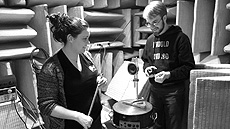Giving physics students options
 |
Many physics degree programs excel at preparing students for an academic career, but more than half of those who complete the programs head to industry instead. Photo courtesy of Kettering University |
"I was drawn to physics because I thought it was amazing," says Crystal Bailey, recalling the beginnings of her graduate work in the early 2000s. "There's a sense of wonder that we're really understanding something fundamental and elegant about the universe."
But when she decided that an academic career path wasn't right for her, she left her degree program. Bailey assumed, like many physics students, that the purpose of earning a physics degree is to remain in academia. In fact, statistics describe a different reality.
The American Institute of Physics states that roughly half of those who enter the workforce with a degree in physics — either a bachelor's, master's or doctorate — work in the private sector.
In an AIP survey of Ph.D. recipients who had earned their degrees the previous year, 64 percent of respondents who identified their jobs as potentially permanent positions were working in industry.
Institutions in the United States currently grant around 1,700 physics Ph.D.s each year, though only about 350 academic faculty positions become available in that time, according to the AIP.
Most university physics programs are rooted in academic tradition, and some members of the physics community have expressed concern that not enough emphasis is placed on preparing students for potential jobs in industry. Among these members are the professors and students in three physics programs that are bucking this trend, taking a decidedly different approach to prepare aspiring physicists for what awaits beyond graduation.
Read more
—Troy Rummler
|